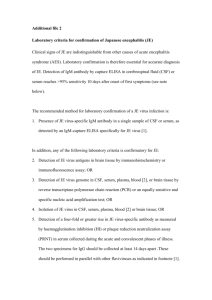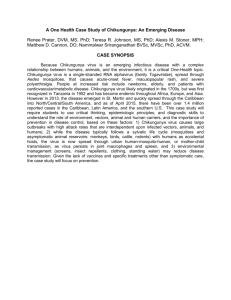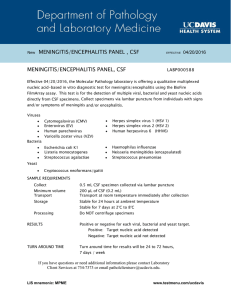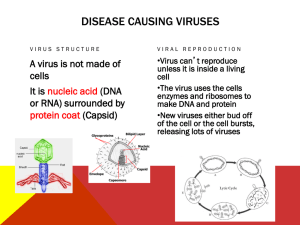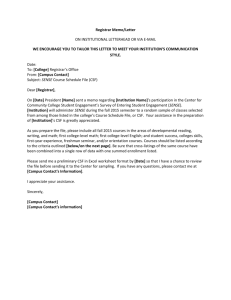Document 13607969
advertisement
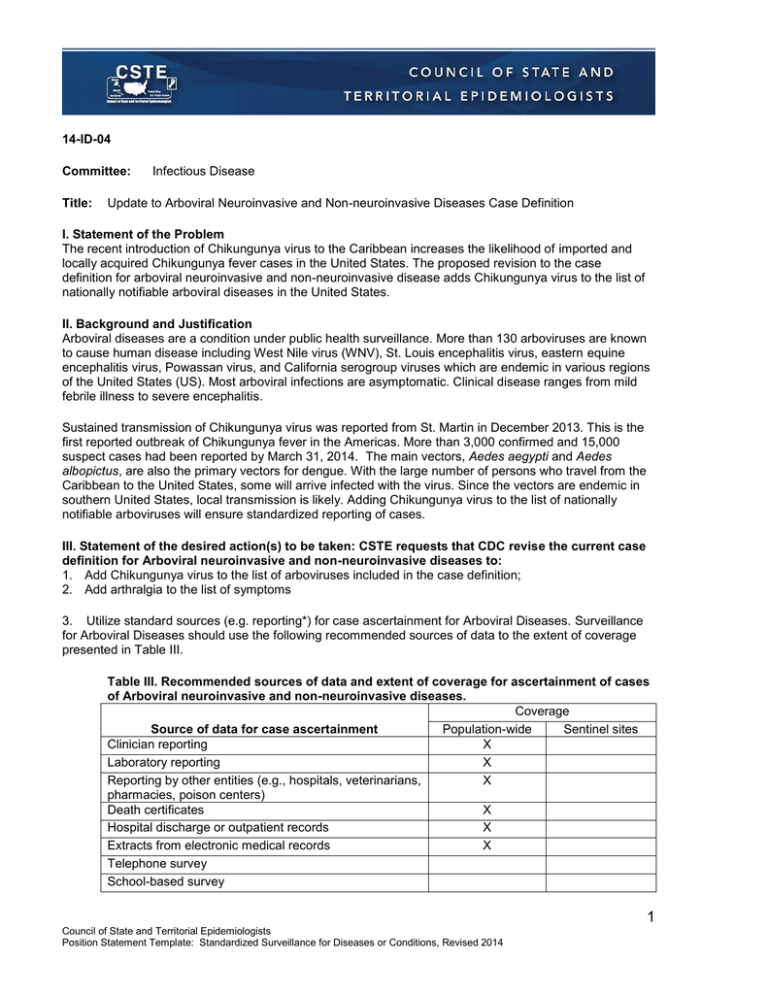
14-ID-04 Committee: Title: Infectious Disease Update to Arboviral Neuroinvasive and Non-neuroinvasive Diseases Case Definition I. Statement of the Problem The recent introduction of Chikungunya virus to the Caribbean increases the likelihood of imported and locally acquired Chikungunya fever cases in the United States. The proposed revision to the case definition for arboviral neuroinvasive and non-neuroinvasive disease adds Chikungunya virus to the list of nationally notifiable arboviral diseases in the United States. II. Background and Justification Arboviral diseases are a condition under public health surveillance. More than 130 arboviruses are known to cause human disease including West Nile virus (WNV), St. Louis encephalitis virus, eastern equine encephalitis virus, Powassan virus, and California serogroup viruses which are endemic in various regions of the United States (US). Most arboviral infections are asymptomatic. Clinical disease ranges from mild febrile illness to severe encephalitis. Sustained transmission of Chikungunya virus was reported from St. Martin in December 2013. This is the first reported outbreak of Chikungunya fever in the Americas. More than 3,000 confirmed and 15,000 suspect cases had been reported by March 31, 2014. The main vectors, Aedes aegypti and Aedes albopictus, are also the primary vectors for dengue. With the large number of persons who travel from the Caribbean to the United States, some will arrive infected with the virus. Since the vectors are endemic in southern United States, local transmission is likely. Adding Chikungunya virus to the list of nationally notifiable arboviruses will ensure standardized reporting of cases. III. Statement of the desired action(s) to be taken: CSTE requests that CDC revise the current case definition for Arboviral neuroinvasive and non-neuroinvasive diseases to: 1. Add Chikungunya virus to the list of arboviruses included in the case definition; 2. Add arthralgia to the list of symptoms 3. Utilize standard sources (e.g. reporting*) for case ascertainment for Arboviral Diseases. Surveillance for Arboviral Diseases should use the following recommended sources of data to the extent of coverage presented in Table III. Table III. Recommended sources of data and extent of coverage for ascertainment of cases of Arboviral neuroinvasive and non-neuroinvasive diseases. Coverage Source of data for case ascertainment Population-wide Sentinel sites Clinician reporting X Laboratory reporting X Reporting by other entities (e.g., hospitals, veterinarians, X pharmacies, poison centers) Death certificates X Hospital discharge or outpatient records X Extracts from electronic medical records X Telephone survey School-based survey 1 Council of State and Territorial Epidemiologists Position Statement Template: Standardized Surveillance for Diseases or Conditions, Revised 2014 Other _________________________ 4. Utilize standardized criteria for case identification and classification (Sections VI and VII) for case ascertainment for Arboviral Diseases and add case ascertainment for Arboviral Diseases to the Nationally Notifiable Condition List. 4a. Immediately notifiable, extremely urgent (within 4 hours) 4b. Immediately notifiable, urgent (within 24 hours) 4c. Routinely notifiable CSTE recommends that all States and Territories enact laws (statute or rule/regulation as appropriate) to make this disease or condition reportable in their jurisdiction. Jurisdictions (e.g. States and Territories) conducting surveillance (according to these methods) should submit case notifications** to CDC. 5. CDC should publish data on case ascertainment for Arboviral Diseases as appropriate in MMWR and other venues (see Section IX). CSTE recommends that all jurisdictions (e.g. States or Territories) with legal authority to conduct public health surveillance follow the recommended methods as outlined above. Terminology: * Reporting: process of a healthcare provider or other entity submitting a report (case information) of a condition under public health surveillance TO local or state public health. **Notification: process of a local or state public health authority submitting a report (case information) of a condition on the Nationally Notifiable Condition List TO CDC. IV. Goals of Surveillance To provide information on the temporal, geographic, and demographic occurrence of arboviral diseases to facilitate prevention and control for these vector-borne infections. V. Methods for Surveillance: Surveillance for Arboviral neuroinvasive and non-neuroinvasive diseases should use the recommended sources of data and the extent of coverage listed in Table III. VI. Criteria for case identification A. Narrative: A description of suggested criteria for case ascertainment of a specific condition. Report any illness to public health authorities that meets any of the following criteria. ● Any person with laboratory evidence of recent arboviral infection as indicated by: o Isolation of arbovirus from, or demonstration of specific arbovirus antigen or nucleic acid in, tissue, blood, cerebrospinal fluid (CSF), or other body fluid o Four-fold or greater change in arbovirus-specific quantitative antibody titers in paired sera o Arbovirus-specific immunoglobulin M (IgM) antibodies in CSF or serum ● A person whose healthcare record contains a diagnosis of an arboviral infection ● A person whose death certificate lists an arboviral infection as a cause of death or a significant condition contributing to death 2 Council of State and Territorial Epidemiologists Position Statement Template: Standardized Surveillance for Diseases or Conditions, Revised 2014 B. Table of criteria to determine whether a case should be reported to public health authorities Table VI-B.Table of criteria to determine whether a case should be reported to public health authorities. Criterion Arboviral Arboviral NonNeuroinvasive neuroinvasive Disease Disease Clinical Evidence Healthcare record contains a diagnosis of arboviral S S infection Death certificate lists arboviral disease as a cause of death S S or a significant condition contributing to death Laboratory Evidence Isolation of arbovirus from, or demonstration of arbovirusS S specific antigen or nucleic acid in, tissue, blood, CSF, or other body fluid Four-fold or greater change in arbovirus-specific S S quantitative antibody titers in paired sera Arbovirus-specific immunoglobulin M (IgM) antibodies in S S CSF or serum Notes: S = This criterion alone is Sufficient to report a case. N = All “N” criteria in the same column are Necessary to report a case. O = At least one of these “O” (Optional) criteria in each category (e.g., clinical evidence and laboratory evidence) in the same column—in conjunction with all “N” criteria in the same column—is required to report a case. * A requisition or order for any of the “S” laboratory tests is sufficient to meet the reporting criteria. C. Disease-specific data elements Clinical Information Underlying chronic illness Immune suppression Blood transfusion in past 30 days Blood donation in past 30 days Organ transplant recipient in past 30 days Organ donor Pregnant Prenatal exposure Breast fed Laboratory exposure Hospitalized Fatality Epidemiologic Risk Factors Occupation Travel in 5-15 days prior to onset of illness County and State where infection was presumably contracted Mosquito exposure 3 Council of State and Territorial Epidemiologists Position Statement Template: Standardized Surveillance for Diseases or Conditions, Revised 2014 VII. Case Definition for Case Classification A. Narrative: Description of criteria to determine how a case should be classified. Arboviruses-which include but are not limited to: ● California serogroup viruses (California encephalitis, Jamestown Canyon, Keystone, La Crosse, Snowshoe hare, and Trivittatus viruses) ● Eastern equine encephalitis virus ● Powassan virus ● St. Louis encephalitis virus ● West Nile virus ● Western equine encephalitis virus ● Chikungunya virus Background Arthropod-borne viruses (arboviruses) are transmitted to humans primarily through the bites of infected mosquitoes, ticks, sand flies, or midges. Other modes of transmission for some arboviruses include blood transfusion, organ transplantation, perinatal transmission, breast feeding, and laboratory exposures. More than 130 arboviruses are known to cause human disease. Most arboviruses of public health importance belong to one of three virus genera: Flavivirus, Alphavirus, and Orthobunyavirus. Clinical Description Most arboviral infections are asymptomatic. Clinical disease ranges from mild febrile illness to severe encephalitis. For the purpose of surveillance and reporting, based on their clinical presentation, arboviral disease cases are often categorized into two primary groups: neuroinvasive disease and nonneuroinvasive disease. Neuroinvasive disease Many arboviruses cause neuroinvasive disease such as aseptic meningitis, encephalitis, or acute flaccid paralysis (AFP). These illnesses are usually characterized by the acute onset of fever with headache, myalgia, stiff neck, altered mental status, seizures, limb weakness, or CSF pleocytosis. AFP may result from anterior myelitis, peripheral neuritis, or post-infectious peripheral demyelinating neuropathy (i.e., Guillain-Barre’ syndrome). Less common neurological manifestations, such as cranial nerve palsies, also occur. Non-neuroinvasive disease Most arboviruses are capable of causing an acute systemic febrile illness (e.g., West Nile fever) that may include headache, myalgia, arthralgia, rash, or gastrointestinal symptoms. Some viruses also can cause more characteristic clinical manifestations, such as severe polyarthralgia or arthritis due to Chikungunya virus or other alphaviruses (e.g., Mayaro, Ross River, O’nyong-nyong). Clinical Criteria A clinically compatible case of arboviral disease is defined as follows: Neuroinvasive disease ● Meningitis, encephalitis, acute flaccid paralysis, or other acute signs of central or peripheral neurologic dysfunction, as documented by a physician, AND ● Absence of a more likely clinical explanation. Other clinically compatible symptoms of arbovirus disease include: headache, myalgia, rash, arthralgia, vertigo, vomiting, paresis and/ or nuchal rigidity. 4 Council of State and Territorial Epidemiologists Position Statement Template: Standardized Surveillance for Diseases or Conditions, Revised 2014 Non-neuroinvasive disease ● Fever (chills) as reported by the patient or a health-care provider, AND ● Absence of neuroinvasive disease, AND ● Absence of a more likely clinical explanation. Other clinically compatible symptoms of arbovirus disease include: headache, myalgia, rash, arthralgia, vertigo, vomiting, paresis and/ or nuchal rigidity. Laboratory Criteria ● Isolation of virus from, or demonstration of specific viral antigen or nucleic acid in, tissue, blood, CSF, or other body fluid, OR ● Four-fold or greater change in virus-specific quantitative antibody titers in paired sera, OR ● Virus-specific IgM antibodies in serum with confirmatory virus-specific neutralizing antibodies in the same or a later specimen, OR ● Virus-specific IgM antibodies in CSF or serum. Case classification Confirmed: Neuroinvasive disease A case that meets the above clinical criteria for neuroinvasive disease and one or more of the following laboratory criteria for a confirmed case: ● Isolation of virus from, or demonstration of specific viral antigen or nucleic acid in, tissue, blood, CSF, or other body fluid, OR ● Four-fold or greater change in virus-specific quantitative antibody titers in paired sera, OR ● Virus-specific IgM antibodies in serum with confirmatory virus-specific neutralizing antibodies in the same or a later specimen, OR ● Virus-specific IgM antibodies in CSF, with our without a reported pleocytosis, and a negative result for other IgM antibodies in CSF for arboviruses endemic to the region where exposure occurred. Non-neuroinvasive disease A case that meets the above clinical criteria for non-neuroinvasive disease and one or more of the following laboratory criteria for a confirmed case: ● Isolation of virus from, or demonstration of specific viral antigen or nucleic acid in, tissue, blood, or other body fluid, excluding CSF, OR ● Four-fold or greater change in virus-specific quantitative antibody titers in paired sera, OR ● Virus-specific IgM antibodies in serum with confirmatory virus-specific neutralizing antibodies in the same or a later specimen. Probable Neuroinvasive disease A case that meets the above clinical criteria for neuroinvasive disease and the following laboratory criteria: ● Virus-specific IgM antibodies in CSF or serum but with no other testing. Non-neuroinvasive disease A case that meets the above clinical criteria for non-neuroinvasive disease and the laboratory criteria for a probable case: ● Virus-specific IgM antibodies in serum but with no other testing. 5 Council of State and Territorial Epidemiologists Position Statement Template: Standardized Surveillance for Diseases or Conditions, Revised 2014 B. Classification Tables Table VII-B.Criteria for defining a case of Arboviral Disease. Criterion Clinical Evidence Fever (chills) Headache Myalgia Rash Arthralgia Vertigo Vomiting Paresis Nuchal rigidity Neurologic illness Aseptic meningitis Encephalitis Myelitis Disorientation Obtundation Peripheral demyelinating neuropathy Acute Flaccid Paralysis Nerve palsies Peripheral neuritis Sensory deficit Abnormal reflexes Seizures Absence of a more likely clinical explanation for the illness Laboratory evidence CSF pleocytosis Isolation of arbovirus from tissue, blood, or other body fluid, excluding CSF Demonstration of specific viral antigen in tissue, blood, or other body fluid, excluding CSF Demonstration of nucleic acid in tissue, blood, or other body fluid, excluding CSF Isolation of arbovirus in CSF Demonstration of specific viral antigen or nucleic acid in CSF Four-fold or greater change in virus-specific quantitative antibody titers in paired sera Neuroinvasive Confirmed Probable Non-neuroinvasive Confirmed Probable O O O O O O O O O N O O O O O O O O O O O O O O N O O O O O N O O O O O O O O A A A A A A N O O O O O O O O A A A A A A O O O O O O O O O O O O O O A A A A A A A A A A A A A A N N N N O O A A O O A A O O A A O A O A O A A A O A A A O A O A 6 Council of State and Territorial Epidemiologists Position Statement Template: Standardized Surveillance for Diseases or Conditions, Revised 2014 Arbovirus-specific IgM antibodies in serum with confirmatory virus-specific neutralizing antibodies in same or later specimen O A O A Arbovirus-specific IgM antibodies in CSF and a negative result for IgM antibodies in CSF for other arboviruses in the same virus O A A A family endemic to the region where exposure occurred Arbovirus-specific IgM antibodies in CSF but with no A O A A other testing Arbovirus-specific IgM antibodies in serum but with no A O A N other testing Criteria to distinguish a new case: Not counted as a new case if previously classified as a case, e.g., previously documented to N N N N have virus-specific IgM antibodies in CSF or serum Notes: S = This criterion alone is Sufficient to classify a case. N = All “N” criteria in the same column are Necessary to classify a case. A number following an “N” indicates that this criterion is only required for a specific disease/condition subtype (see below). A = This criterion must be absent (i.e., NOT present) for the case to meet the classification criteria. O = At least one of these “O” (Optional) criteria in each category (e.g., clinical evidence and laboratory evidence) in the same column—in conjunction with all “N” criteria in the same column—is required to classify a case. (These optional criteria are alternatives, which mean that a single column will have either no O criteria or multiple O criteria; no column should have only one O.) A number following an “O” indicates that this criterion is only required for a specific disease/condition subtype. 7 Council of State and Territorial Epidemiologists Position Statement Template: Standardized Surveillance for Diseases or Conditions, Revised 2014 VIII. Period of Surveillance Surveillance should be ongoing. IX. Data sharing/release and print criteria. ● Notification to CDC of confirmed and probable cases of arboviral diseases is recommended. ● CDC Division of Vector-Borne Diseases (DVBD) staff review, analyze, and summarize the national data weekly. Provisional state-specific arboviral disease case counts are provided weekly in the MMWR nationally notifiable diseases tables. Tables and maps are also provided on the CDC DVBD and U.S. Geologic Survey (USGS) websites. These provisional data are used to: 1) Monitor the epidemiology and geographic spread of arboviral diseases; 2) Provide timely information regarding regional and national trends in arboviral diseases to public health officials and others; and 3) Identify geographic areas where additional prevention and control efforts may be needed. In circumstances where there is a potential for an international health impact, data from these notifications may be shared with international partners (e.g., PHAC, ECDC, WHO, PAHO). ● Final data are published annually in the MMWR Summary of Notifiable Diseases, posted on the CDC DVBD website, and presented or published at scientific meetings and in peer-reviewed literature. Additional tables and limited use datasets are available to researchers, pharmaceutical companies, media, and the general public upon request to the CDC DVBD. These final data are used to: 1) Monitor the epidemiology, incidence, and geographic spread of arboviral diseases; 2) Identify geographic areas in which it may be appropriate to conduct analytic studies of control methods, risk factors, disease severity, or other public health aspects; and 3) Evaluate arboviral disease funding needs and allocate resources. ● All cases are verified with the state health departments before publication. Individual case notifications are made to state and local health departments depending on circumstances. For example, viremic blood donors or transplant or transfusion-associated cases require rapid notification and investigation. ● To facilitate access to ArboNET data while maintaining patient confidentiality, and to ensure that users understand the limitations of the data, the CDC Arboviral Diseases Branch has developed data sharing and release guidelines, a data request form, and a data use agreement. These policies and procedures are consistent with those developed by CDC and the CSTE for the release and sharing of data reported to the Nationally Notifiable Diseases Surveillance System (NNDSS). X. References XI. Coordination Agencies for Response (1) Thomas R. Frieden, MD, MPH Centers for Disease Control and Prevention Director 1600 Clifton Road, NE Atlanta, GA 30333 (404) 639-7000 txf2@cdc.gov 8 Council of State and Territorial Epidemiologists Position Statement Template: Standardized Surveillance for Diseases or Conditions, Revised 2014 XII. Submitting Author: (1) Carina Blackmore, DVM, Ph.D. Deputy State Epidemiologist and State Public Health Veterinarian Florida Department of Health 4052 Bald Cypress Way, Bin A-09 Tallahassee, FL 32330 (850) 245-4732 Carina.Blackmore@FLHealth.gov Co-Author: (1) Kristy K. Bradley, DVM, MPH State Epidemiologist and State Public Health Veterinarian Oklahoma State Department of Health 1000 NE Tenth Street Room 606 Oklahoma City, OK 73117 405-271-7637 kristyb@health.ok.gov 9 Council of State and Territorial Epidemiologists Position Statement Template: Standardized Surveillance for Diseases or Conditions, Revised 2014
